1. 第一章课后习题及答案
中学教育学课后习题及参考答案
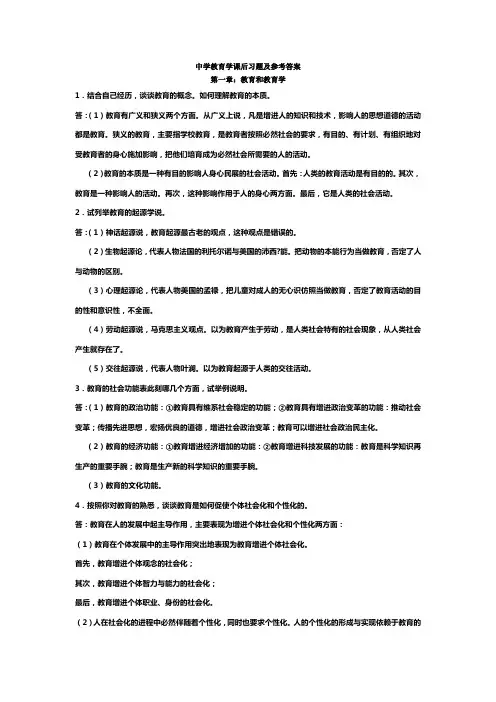
中学教育学课后习题及参考答案第一章:教育和教育学1.结合自己经历,谈谈教育的概念。
如何理解教育的本质。
答:(1)教育有广义和狭义两个方面。
从广义上说,凡是增进人的知识和技术,影响人的思想道德的活动都是教育。
狭义的教育,主要指学校教育,是教育者按照必然社会的要求,有目的、有计划、有组织地对受教育者的身心施加影响,把他们培育成为必然社会所需要的人的活动。
(2)教育的本质是一种有目的影响人身心民展的社会活动。
首先:人类的教育活动是有目的的。
其次,教育是一种影响人的活动。
再次,这种影响作用于人的身心两方面。
最后,它是人类的社会活动。
2.试列举教育的起源学说。
答:(1)神话起源说,教育起源最古老的观点,这种观点是错误的。
(2)生物起源论,代表人物法国的利托尔诺与美国的沛西?能。
把动物的本能行为当做教育,否定了人与动物的区别。
(3)心理起源论,代表人物美国的孟禄,把儿童对成人的无心识仿照当做教育,否定了教育活动的目的性和意识性,不全面。
(4)劳动起源说,马克思主义观点。
以为教育产生于劳动,是人类社会特有的社会现象,从人类社会产生就存在了。
(5)交往起源说,代表人物叶澜。
以为教育起源于人类的交往活动。
3.教育的社会功能表此刻哪几个方面,试举例说明。
答:(1)教育的政治功能:①教育具有维系社会稳定的功能;②教育具有增进政治变革的功能:推动社会变革;传播先进思想,宏扬优良的道德,增进社会政治变革;教育可以增进社会政治民主化。
(2)教育的经济功能:①教育增进经济增加的功能:②教育增进科技发展的功能:教育是科学知识再生产的重要手腕;教育是生产新的科学知识的重要手腕。
(3)教育的文化功能。
4.按照你对教育的熟悉,谈谈教育是如何促使个体社会化和个性化的。
答:教育在人的发展中起主导作用,主要表现为增进个体社会化和个性化两方面:(1)教育在个体发展中的主导作用突出地表现为教育增进个体社会化。
首先,教育增进个体观念的社会化;其次,教育增进个体智力与能力的社会化;最后,教育增进个体职业、身份的社会化。
《高等数学一》第一章-函数--课后习题(含答案解析)
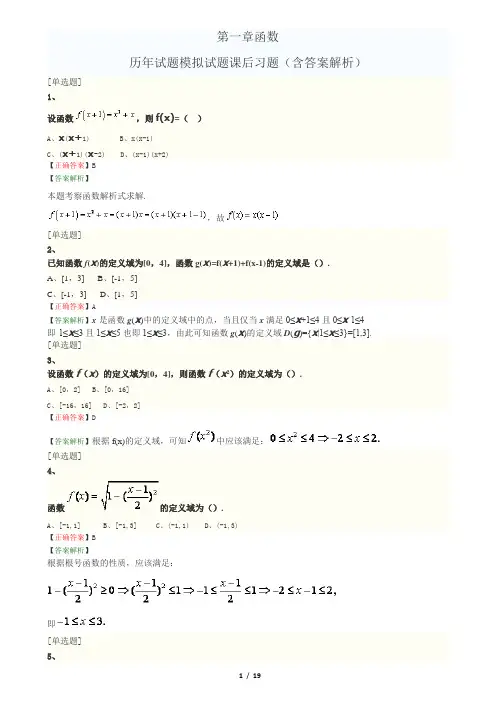
第一章函数历年试题模拟试题课后习题(含答案解析)[单选题]1、设函数,则f(x)=()A、x(x+1)B、x(x-1)C、(x+1)(x-2)D、(x-1)(x+2)【正确答案】B【答案解析】本题考察函数解析式求解.,故[单选题]2、已知函数f(x)的定义域为[0,4],函数g(x)=f(x+1)+f(x-1)的定义域是().A、[1,3]B、[-1,5]C、[-1,3]D、[1,5]【正确答案】A【答案解析】x是函数g(x)中的定义域中的点,当且仅当x满足0≤x+1≤4且0≤x-1≤4即-1≤x≤3且1≤x≤5也即1≤x≤3,由此可知函数g(x)的定义域D(g)={x|1≤x≤3}=[1,3]. [单选题]3、设函数f(x)的定义域为[0,4],则函数f(x2)的定义域为().A、[0,2]B、[0,16]C、[-16,16]D、[-2,2]【正确答案】D【答案解析】根据f(x)的定义域,可知中应该满足:[单选题]4、函数的定义域为().A、[-1,1]B、[-1,3]C、(-1,1)D、(-1,3)【正确答案】B【答案解析】根据根号函数的性质,应该满足:即[单选题]写出函数的定义域及函数值().A、B、C、D、【正确答案】C【答案解析】分段函数的定义域为各个分段区间定义域的并集,故D=(-∞,-1]∪(-1,+∞).[单选题]6、设函数,则对所有的x,则f(-x)=().A、B、C、D、【正确答案】A【答案解析】本题考察三角函数公式。
.[单选题]7、设则=().A、B、C、D、【正确答案】B【答案解析】令则,故[单选题]8、则().A、B、C、D、【正确答案】D【答案解析】[单选题]9、在R上,下列函数中为有界函数的是().xA、eB、1+sin xC、ln x【正确答案】B【答案解析】由函数图像不难看出在R上e x,lnx,tanx都是无界的,只有1+sinx可能有界,由于|sinx|≤1,|1+sinx|≤1+|sinx|≤2所以有界.[单选题]10、不等式的解集为().A、B、C、D、【正确答案】D【答案解析】[单选题]11、().A、B、C、D、【正确答案】A【答案解析】根据二角和公式,[单选题]12、函数的反函数是().A、B、C、D、【正确答案】A【答案解析】由所以,故.[单选题]13、已知则().A、B、C、D、【正确答案】C【答案解析】[单选题]14、已知为等差数列,,则().A、-2B、1C、3D、7【正确答案】A因为同理可得:故d=a4-a3=-2.[单选题]15、计算().A、B、C、D、【正确答案】A【答案解析】根据偶次根式函数的意义,可知,故[单选题]16、计算().A、0B、1C、2D、4【正确答案】C【答案解析】原式=[单选题]将函数|表示为分段函数时,=().A、B、C、D、【正确答案】B【答案解析】由条件[单选题]18、函数f(x)=是().A、奇函数B、偶函数C、有界函数D、周期函数【正确答案】C【答案解析】易知不是周期函数,,即不等于,也不等于,故为非奇、非偶函数.,故为有界函数.[单选题]19、函数,则的定义域为().A、[1,5]C、(1,5]D、[1,5)【正确答案】A【答案解析】由反正切函数的定义域知:,故定义域为[1,5].[单选题]20、下列等式成立的是()A、B、C、D、【正确答案】B【答案解析】A中(e x)2=,C中,D中[单选题]21、下列函数为偶函数的是()A、y=xsinxB、y=xcosxC、y=sinx+cosxD、y=x(sinx+cosx)【正确答案】A【答案解析】sinx是奇函数,cosx是偶函数。
中级会计职称第1章课后习题及答案

中级会计职称《中级会计实务》第一章课后练习题及答案第一章总论一、单项选择题1.下列项目中,不属于财务报告目标的是()。
A.向财务报告使用者提供与企业财务状况有关的会计信息B.向财务报告使用者提供与企业现金流量有关的会计信息C.反映企业管理层受托责任履行情况D.满足企业内部管理需要答案:D解析:财务报告的目标是向财务报告使用者提供与企业财务状况、经营成果和现金流量等有关的会计信息,反映企业管理层受托责任履行情况,有助于财务报告使用者作出经济决策。
财务报告目标不是满足企业内部管理的需要。
2.会计基本假设不包括()A.会计主体假设B.持续经营假设C.会计分期假设D.实物计量假设答案:D解析:会计基本假设包括会计主体假设、持续经营假设、会计分期假设和货币计量假设。
不包括实物计量假设。
3.()不是企业会计确认计量和报告选择货币计量的原因。
A.货币是商品的一般等价物B.货币是衡量一般商品的共同尺度C.只能从一个侧面反映企业的生产经营情况D.货币是价值尺度和流通手段答案:C解析:货币是商品的一般等价物,是衡量一般商品价值的共同尺度,具有价值尺度、流通手段、储藏手段和支付手段等特点。
4.下列关于权责发生制的表述中不正确的是()。
A.凡是当期已经实现的收入和应当负担的费用,无论款项是否收付都应当作为当期的收入和费用B.凡是不属于当期的收入和费用,即使款项已在当期收付,也不应当作为当期的收入和费用C.款项已收到,但销售并未实现,收到款项时确认收入D.费用已经发生,但款项并没有支付,费用发生时确认费用答案:C解析:根据权责发生制要求,应该是在销售实现时确认收入,而不是收到款项时确认收入。
5.下列项目中,不违背会计核算可比性要求的是()。
A.当固定资产价值恢复时,将以前年度计提的减值准备转回B.由于利润计划完成情况不佳,将以前年度计提的坏账准备全额转回C.固定资产达到预定可使用状态之后,利息费用继续资本化D.某项专利技术已经陈旧,已不能为企业带来经济利益。
第一章衍生金融工具概述课后习题及答案
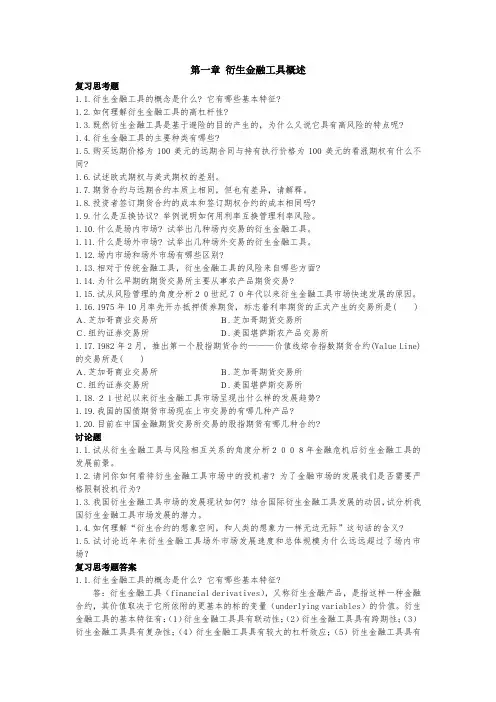
第一章衍生金融工具概述复习思考题1.1.衍生金融工具的概念是什么? 它有哪些基本特征?1.2.如何理解衍生金融工具的高杠杆性?1.3.既然衍生金融工具是基于避险的目的产生的,为什么又说它具有高风险的特点呢? 1.4.衍生金融工具的主要种类有哪些?1.5.购买远期价格为100美元的远期合同与持有执行价格为100美元的看涨期权有什么不同?1.6.试述欧式期权与美式期权的差别。
1.7.期货合约与远期合约本质上相同,但也有差异,请解释。
1.8.投资者签订期货合约的成本和签订期权合约的成本相同吗?1.9.什么是互换协议? 举例说明如何用利率互换管理利率风险。
1.10.什么是场内市场? 试举出几种场内交易的衍生金融工具。
1.11.什么是场外市场? 试举出几种场外交易的衍生金融工具。
1.12.场内市场和场外市场有哪些区别?1.13.相对于传统金融工具,衍生金融工具的风险来自哪些方面?1.14.为什么早期的期货交易所主要从事农产品期货交易?1.15.试从风险管理的角度分析20世纪70年代以来衍生金融工具市场快速发展的原因。
1.16.1975年10月率先开办抵押债券期货,标志着利率期货的正式产生的交易所是( ) A.芝加哥商业交易所B.芝加哥期货交易所C.纽约证券交易所D.美国堪萨斯农产品交易所1.17.1982年2月,推出第一个股指期货合约———价值线综合指数期货合约(Value Line)的交易所是( )A.芝加哥商业交易所B.芝加哥期货交易所C.纽约证券交易所D.美国堪萨斯交易所1.18.21世纪以来衍生金融工具市场呈现出什么样的发展趋势?1.19.我国的国债期货市场现在上市交易的有哪几种产品?1.20.目前在中国金融期货交易所交易的股指期货有哪几种合约?讨论题1.1.试从衍生金融工具与风险相互关系的角度分析2008年金融危机后衍生金融工具的发展前景。
1.2.请问你如何看待衍生金融工具市场中的投机者? 为了金融市场的发展我们是否需要严格限制投机行为?1.3.我国衍生金融工具市场的发展现状如何? 结合国际衍生金融工具发展的动因,试分析我国衍生金融工具市场发展的潜力。
第一章衍生金融工具概述课后习题及答案
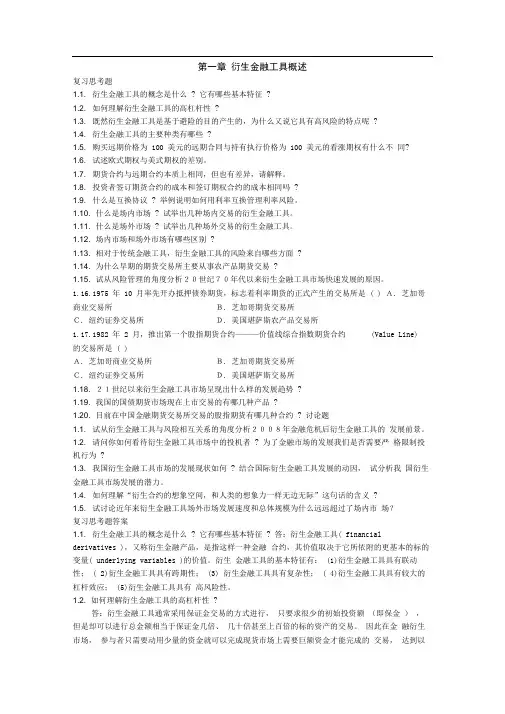
第一章衍生金融工具概述复习思考题1.1. 衍生金融工具的概念是什么 ? 它有哪些基本特征 ?1.2. 如何理解衍生金融工具的高杠杆性 ?1.3. 既然衍生金融工具是基于避险的目的产生的,为什么又说它具有高风险的特点呢 ?1.4. 衍生金融工具的主要种类有哪些 ?1.5. 购买远期价格为 100 美元的远期合同与持有执行价格为 100 美元的看涨期权有什么不同?1.6. 试述欧式期权与美式期权的差别。
1.7. 期货合约与远期合约本质上相同,但也有差异,请解释。
1.8. 投资者签订期货合约的成本和签订期权合约的成本相同吗 ?1.9. 什么是互换协议 ? 举例说明如何用利率互换管理利率风险。
1.10. 什么是场内市场 ? 试举出几种场内交易的衍生金融工具。
1.11. 什么是场外市场 ? 试举出几种场外交易的衍生金融工具。
1.12. 场内市场和场外市场有哪些区别 ?1.13. 相对于传统金融工具,衍生金融工具的风险来自哪些方面 ?1.14. 为什么早期的期货交易所主要从事农产品期货交易 ?1.15. 试从风险管理的角度分析20世纪70年代以来衍生金融工具市场快速发展的原因。
1.16.1975 年 10 月率先开办抵押债券期货,标志着利率期货的正式产生的交易所是 ( ) A. 芝加哥商业交易所B. 芝加哥期货交易所C. 纽约证券交易所D. 美国堪萨斯农产品交易所1.17.1982 年 2 月,推出第一个股指期货合约———价值线综合指数期货合约(Value Line)的交易所是 ( )A. 芝加哥商业交易所B. 芝加哥期货交易所C. 纽约证券交易所D. 美国堪萨斯交易所1.18. 21世纪以来衍生金融工具市场呈现出什么样的发展趋势 ?1.19. 我国的国债期货市场现在上市交易的有哪几种产品 ?1.20. 目前在中国金融期货交易所交易的股指期货有哪几种合约 ? 讨论题1.1. 试从衍生金融工具与风险相互关系的角度分析2008年金融危机后衍生金融工具的发展前景。
中国近代史课后习题及答案
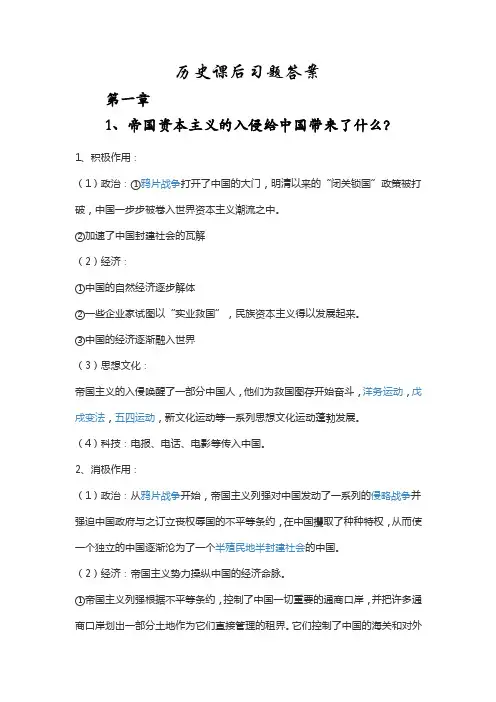
历史课后习题答案第一章1、帝国资本主义的入侵给中国带来了什么?1、积极作用:(1)政治:①鸦片战争打开了中国的大门,明清以来的“闭关锁国”政策被打破,中国一步步被卷入世界资本主义潮流之中。
②加速了中国封建社会的瓦解(2)经济:①中国的自然经济逐步解体②一些企业家试图以“实业救国”,民族资本主义得以发展起来。
③中国的经济逐渐融入世界(3)思想文化:帝国主义的入侵唤醒了一部分中国人,他们为救国图存开始奋斗,洋务运动,戊戌变法,五四运动,新文化运动等一系列思想文化运动蓬勃发展。
(4)科技:电报、电话、电影等传入中国。
2、消极作用:(1)政治:从鸦片战争开始,帝国主义列强对中国发动了一系列的侵略战争并强迫中国政府与之订立丧权辱国的不平等条约,在中国攫取了种种特权,从而使一个独立的中国逐渐沦为了一个半殖民地半封建社会的中国。
(2)经济:帝国主义势力操纵中国的经济命脉。
①帝国主义列强根据不平等条约,控制了中国一切重要的通商口岸,并把许多通商口岸划出一部分土地作为它们直接管理的租界。
它们控制了中国的海关和对外贸易,控制了中国的交通事业。
因此它们便能够大量地倾销它们的商品,把中国变成它们的工业品的市场,同时又使中国的农业生产服从于帝国主义的需要。
②在经济上中国逐步地形成了对帝国主义资本的依附而丧失了自己的独立性。
③资本主义国家一定程度上压制着民族资本主义的进一步发展,民族资本主义逐渐陷入困境。
(3)思想文化:①西方思想文化对中国传统思想文化的冲击。
②圆明园等宝贵的历史文化财富被帝国主义摧毁(4)对人民:大量中国人民惨遭杀害,是历史的巨大灾难。
2、反对外国侵略的斗争具有什么意义?第一,近代中国人民进行的反侵略战争,沉重打击了帝国主义侵华的野心,粉碎了他们瓜分中国和把中国变成完全殖民地的图谋。
帝国主义列强一次次对中国发动侵略战争,绝不仅仅是为了通商,而是为了掠夺和扩大殖民地,为了他们自身的殖民扩张利益。
每一次战争,都伴随着更大的贪梦目的和更多的利益要求。
第一章 课后习题及参考答案
第一章习题一、选择题1.世界上第一台通用电子数字计算机诞生于( C )。
A、1950年B、1945年C、1946年D、1948年2.与二进制数(10111.101)2等值的十进制数是( A )。
A、23.625B、23.5C、39.5D、39.6253.与十进制数(101.1)10等值的二进制数是( D )。
A、5.5B、110010.00011C、11000101.0011D、1100101.000110011…4.与十六进制数(1AE.5D)16等值的八进制数是( C )。
A、(647.272)8B、(565.727)8C、(656.272)8D、(656.235)85.与二进制数(1111111111)2等值的十六进制数是( B )。
A、FF3HB、3FFHC、210-1D、1777O6. 在PC机中,1MB准确等于( C )。
A、1000×1000KBB、1024×1024KBC、1024×1024BD、1000×1000B7.已知真值X= +1101010,则其补码[X]补等于( B )。
A、00010110B、01101010C、10010110D、00101108.已知机器数[X]反=11111111,则其真值X为( D )。
A、00000000B、+0000000C、10000000D、-00000009.已知[X]原=10011110,则其对应的[X]补为( D )。
A、01100010B、11100001C、-0011110D、1110001010.已知A =01011101,B =11101010,则A○+B为( A )。
A、10110111B、01001000C、11111111D、1010001011.1MB等于( C )字节?A、10KB、100KC、1024KD、10000K12.把十进制数215转换成二进制数,结果为( D )。
高等数学第1章课后习题答案(科学出版社)
第一章 函数、极限、连续习题1-11.求下列函数的自然定义域:(1)321x y x=+-(2) 1arctany x=+(3) 1arccosx y -=;(4) 313 , 1x y x ⎧≠⎪=⎨⎪=⎩. 解:(1)解不等式组23010x x +≥⎧⎨-≠⎩得函数定义域为[3,1)(1,1)(1,)---+∞U U ; (2)解不等式组230x x ⎧-≥⎨≠⎩得函数定义域为[U ;(3)解不等式组2111560x x x -⎧-≤≤⎪⎨⎪-->⎩得函数定义域为[4,2)(3,6]--U ; (4)函数定义域为(,1]-∞.2.已知函数()f x 定义域为[0,1],求(cos ),()() (0)f f x f x c f x c c ++->的定义域.解:函数f要有意义,必须01≤≤,因此f 的定义域为[0,1];同理得函数(cos )f x 定义域为[2π-,2π]22k k ππ+;函数()()f x c f x c ++-要有意义,必须0101x c x c ≤+≤⎧⎨≤-≤⎩,因此,(1)若12c <,定义域为:[],1c c -;(2)若12c =,定义域为:1{}2;(3)若12c >,定义域为:∅. 3.设21()1,||x a f x x x a ⎛⎫-=- ⎪-⎝⎭0,a >求函数值(2),(1)f a f .解:因为21()1||x a f x x x a ⎛⎫-=- ⎪-⎝⎭,所以 21(2)104a f a a a ⎛⎫=-= ⎪⎝⎭,22 ,>1,11(1)10 ,0<<111a a f a a ⎛⎫⎧-=-= ⎪⎨ ⎪-⎩⎝⎭. 4. 证明下列不等式:(1) 对任何x R ∈有 |1||2|1x x -+-≥; (2) 对任何n Z +∈有 111(1)(1)1n n n n++>++;(3) 对任何n Z +∈及实数1a >有 111na a n--≤.证明:(1)由三角不等式得|1||2||1(2)|1x x x x -+-≥---= (2)要证111(1)(1)1n n n n++>++,即要证111n +>+= 111(1)(1)(1)11111n n n n n +++++++<=+++L 得证。
(完整word版)高一化学必修一课后习题答案
《化学(必修)1》课后习题参考答案第一章第一节1.C 2.C 3.CD 4.略5.乳化原理或萃取原理6.利用和稀盐酸反应产生气体7.不可靠,因为碳酸钡也是白色沉淀,碳酸根干扰了硫酸根的检验。
由于硫酸钡是难溶的强酸盐,不溶于强酸,而碳酸钡是难溶弱酸盐,可溶于强酸,因此可先取样,再滴入氯化钡溶液和几滴稀硝酸或稀盐酸,如果出现白色沉淀,说明有硫酸根。
第一章第二节1.D 2.B 3.B 4.B5.65 mg/dL ~110mg/dL (1mmol=10-3mol)6.这种操作会使得结果偏低,因为倒出去的溶液中含有溶质,相当于容量瓶内的溶质有损失。
7.14mL8.n(Ca):n(Mg):n(Cu):n(Fe)=224:140:35:29.1)0.2mol 2)Cu2+:0。
2mol Cl—:0。
4mol10.40 (M=40 g/mol,该气体的相对分子质量为40。
)第一章复习题1.C 2.B 3.A 4.BC 5.C6.(1) 不正确。
(标况下)(2)不正确.(溶液体积不为1L)(3)不正确。
(水标况下不是气体)(4)正确。
(同温同压下气体的体积比即为物质的量之比,也就是分子个数比)7.(1)5% (2)0.28mol/L8.9.1.42 g,操作步骤略。
第二章第一节1.②⑧ ①④ ⑤ ⑥ ⑦⑩ ⑨ 2.树状分类法略5.分散系分散质粒子大小主要特征举例浊液>100 nm不稳定,不均一泥浆水溶液〈1 nm稳定,均一饱和NaCl溶液胶体1~100 nm较稳定,均一豆浆6.BD7.胶体区别于其他分散系得本质特征是胶体粒子的大小在1~100nm范围。
胶体的应用,例如明矾净水、豆浆加石膏成豆腐、静电除尘、江河入海口易形成沙洲、血液透析、饱和氯化铁溶液用于应急性止血等.第二章第二节1.水溶液熔融状态电离阴阳离子阳离子H+阴离子OH—金属离子或铵根离子酸根离子H+ + OH-=H2O2.两种电解质在溶液中相互交换离子的反应生成难溶物、易挥发物质、弱电解质3.C 4.C 5.C 6.B 7.D8.(1)NaOH=Na++OH—(2) CuCl2=Cu2++2Cl-(3)Fe2(SO4)3=2Fe3++3SO42-(4)Ba(NO3)2=Ba2++2NO3-铁粉过滤Fe、CuFeSO4溶液稀硫酸过滤FeSO4溶液蒸发结晶9.(1)SO42-+Ba2+=BaSO4(2) 2Al+3Hg2+=3Hg+2Al3+(3) CO32—+2H+=H2O+CO2(4) 不反应.10.(1)可溶铜盐+强碱=可溶盐+Cu(OH)2(2)强酸+强碱=可溶盐+H2O(3)强酸+CaCO3=可溶钙盐+H2O+CO2(4)强酸+可溶盐=可溶盐+H2O+CO2(5)可溶铜盐+Fe=可溶铁盐+Cu11.金属导电的原因是自由电子在外加电场下定向移动,形成电流。
《多媒体技术应用》课后习题和答案
《多媒体技术应用》课后习题及答案2009-12第一章习题一、填空题1.多媒体有、、等几个关键性。
2.多媒体外部设备一般分为系统和系统。
3.静态图素材包括和两大类。
4.多媒体制作分为、、、和五个步骤。
5.人机交互界面设计首先要确立,还应该遵循三个原则,它们是、、。
6.屏幕设计的布局应该遵循、、、和五个原则。
7.数据压缩方法可以分为和两大类。
8.目前已经公布的数据压缩标准有:用于静止图像压缩的标准;用于视频和音频编码的系列标准;用于的H.261、H。
263标准;用于的JBIG标准等。
9.光存储技术是一种通过方法读/写数据的存储技术,一般情况下使用作为光源,所以也可称为存储。
10.目前,可以从两个方面来看多媒体技术的发展方向:一是多媒体在朝着、方向发展;二是多媒体在、领域和发展异常迅速且卓有成效。
二、简答题1.多媒体产品的最大特点是什么?2.多媒体能做什么?3.简述多媒体的制作流程。
4.无损压缩和有损压缩有什么异同?5.什么是光存储技术?第一章习题答案一、填空题●1.多样化交互性集成性●2.输入输出●3.图形图像●4.创作脚本流程图素材选取与加工媒体集成产品发布●5.用户类型信息最小量原则帮助和提示原则媒体最佳组合原则●6.平衡原则预期原则经济原则顺序原则规则化原则●7.有损压缩无损压缩●8.JPEG MPEG 视频和音频通信二值图像编码●9.光学激光激光●10.智能化三维化二、简答题●1.多媒体产品的最大特点是什么?●答:多媒体技术具有以下的关键特性:多样化、交互性、集成性。
最大特点是交互性。
●交互性是影视作品和多媒体作品的主要区别,是多媒体产品的最大特点。
它允许用户参与其中,可以通过各种操作去控制整个过程,可以打乱顺序任意选择,可通过有意或无意的操作来改变某些音频或视频元素的特征。
交互实际上就是用户在某种程度上的参与。
●2.多媒体能做什么?●答:多媒体的应用已经涵盖到各行各业,如:广告、展示系统、计算机游戏、教学系统、办公自动化和会议系统、交互式数字电视等●3.简述多媒体的制作流程。
- 1、下载文档前请自行甄别文档内容的完整性,平台不提供额外的编辑、内容补充、找答案等附加服务。
- 2、"仅部分预览"的文档,不可在线预览部分如存在完整性等问题,可反馈申请退款(可完整预览的文档不适用该条件!)。
- 3、如文档侵犯您的权益,请联系客服反馈,我们会尽快为您处理(人工客服工作时间:9:00-18:30)。
第一章1.(Q1) What is the difference between a host and an end system? List the types of endsystems. Is a Web server an end system?Answer: There is no difference. Throughout this text, the words “host” and “end system” are used interchangeably. End systems include PCs, workstations, Web servers, mail servers, Internet-connected PDAs, WebTVs, etc.2.(Q2) The word protocol is often used to describe diplomatic relations. Give an example of adiplomatic protocol.Answer: Suppose Alice, an ambassador of country A wants to invite Bob, an ambassador of country B, over for dinner. Alice doesn’t simply just call Bob on the phone and say, come to our dinner table now”. Instead, she calls Bob and suggests a date and time. Bob may respond by saying he’s not available that particular date, but he is available another date. Alice and Bob continue to send “messages” back and forth until they agree on a date and time. Bob then shows up at the embassy on the agreed date, hopefully not more than 15 minutes before or after the agreed time. Diplomatic protocols also allow for either Alice or Bob to politely cancel the engagement if they have reasonable excuses.3.(Q3) What is a client program? What is a server program? Does a server program requestand receive services from a client program?Answer: A networking program usually has two programs, each running on a different host, communicating with each other. The program that initiates the communication is the client.Typically, the client program requests and receives services from the server program.4.(Q4) List six access technologies. Classify each one as residential access, company access, ormobile access.Answer:1. Dial-up modem over telephone line: residential; 2. DSL over telephone line: residential or small office; 3. Cable to HFC: residential; 4. 100 Mbps switched Etherent: company; 5. Wireless LAN: mobile; 6. Cellular mobile access (for example, 3G/4G): mobile5.(Q5) List the available residential access technologies in your city. For each type of access,provide the advertised downstream rate, upstream rate, and monthly price.Answer: Current possibilities include: dial-up (up to 56kbps); DSL (up to 1 Mbps upstream, up to 8 Mbps downstream); cable modem (up to 30Mbps downstream, 2 Mbps upstream.6.(Q7) What are some of the physical media that Ethernet can run over?Answer: Ethernet most commonly runs over twisted-pair copper wire and “thin” coaxial cable. It also can run over fibers optic links and thick coaxial cable.7.(Q8) Dial-up modems, HFC, and DSL are all used for residential access. For each of theseaccess technologies, provide a range of transmission rates and comment on whether the transmission rate is shared or dedicated.Answer:Dial up modems: up to 56 Kbps, bandwidth is dedicated; ISDN: up to 128 kbps, bandwidth is dedicated; ADSL: downstream channel is .5-8 Mbps, upstream channel is up to1 Mbps, bandwidth is dedicated; HFC, downstream channel is 10-30 Mbps and upstreamchannel is usually less than a few Mbps, bandwidth is shared.8.(Q13) Why is it said that packet switching employs statistical multiplexing? Contraststatistical multiplexing with the multiplexing that takes place in TDM.Answer: In a packet switched network, the packets from different sources flowing on a link do not follow any fixed, pre-defined pattern. In TDM circuit switching, each host gets the same slot in a revolving TDM frame.9.(Q14) Suppose users share a 2Mbps link. Also suppose each user requires 1Mbps whentransmitting, but each user transmits only 20 percent of the time. (See the discussion of statistical multiplexing in Section 1.3.)a.When circuit switching is used, how many users can be supported?b.For the remainder of this problem, suppose packet switching is used. Why will there beessentially no queuing delay before the link if two or fewer users transmit at the same time? Why will there be a queuing delay if three users transmit at the same time?c.Find the probability that a given user is transmitting.d.Suppose now there are three users. Find the probability that at any given time, allthree users are transmitting simultaneously. Find the fraction of time during which the queue grows.Answer:a. 2 users can be supported because each user requires half of the link bandwidth.b.Since each user requires 1Mbps when transmitting, if two or fewer users transmitsimultaneously, a maximum of 2Mbps will be required. Since the available bandwidth of the shared link is 2Mbps, there will be no queuing delay before the link. Whereas, if three users transmit simultaneously, the bandwidth required will be 3Mbps which is more than the available bandwidth of the shared link. In this case, there will be queuing delay before the link.c.Probability that a given user is transmitting = 0.2d.Probability that all three users are transmitting simultaneously=(33)p3(1−p)0=0.23=0.008. Since the queue grows when all the users are transmitting, the fraction oftime during which the queue grows (which is equal to the probability that all three users are transmitting simultaneously) is 0.008.10.(Q16) Consider sending a packet from a source host to a destination host over a fixed route.List the delay components in the end-to-end delay. Which of these delays are constant and which are variable?Answer:The delay components are processing delays, transmission delays, propagation delays, and queuing delays. All of these delays are fixed, except for the queuing delays, which are variable.11.(Q19) Suppose Host A wants to send a large file to Host B. The path from Host A to Host Bhas three links, of rates R1 = 250 kbps, R2 = 500 kbps, and R3 = 1 Mbps.a.Assuming no other traffic in the network, what is the throughput for the file transfer.b.Suppose the file is 2 million bytes. Roughly, how long will it take to transfer the file toHost B?c.Repeat (a) and (b), but now with R2 reduced to 200 kbps.Answer:a.250 kbpsb.64 secondsc.200 kbps; 80 seconds12.(P2) Consider the circuit-switched network in Figure 1.8. Recall that there are n circuits oneach link.a.What is the maximum number of simultaneous connections that can be in progress atany one time in this network?b.Suppose that all connections are between the switch in the upper-left-hand cornerand the switch in the lower-right-hand corner. What is the maximum number ofsimultaneous connections that can be in progress?Answer:a.We can n connections between each of the four pairs of adjacent switches. This gives amaximum of 4n connections.b.We can n connections passing through the switch in the upper-right-hand corner andanother n connections passing through the switch in the lower-left-hand corner, giving a total of 2n connections.13.(P4) Review the car-caravan analogy in Section 1.4. Assume a propagation speed of 50km/hour.a.Suppose the caravan travels 150 km, beginning in front of one tollbooth, passingthrough a second tollbooth, and finishing just before a third tollbooth. What is theend-to-end delay?b.Repeat (a), now assuming that there are five cars in the caravan instead of ten.Answer: Tollbooths are 150 km apart, and the cars propagate at 50 km/hr, A tollbooth services a car at a rate of one car every 12 seconds.a.There are ten cars. It takes 120 seconds, or two minutes, for the first tollbooth to servicethe 10 cars. Each of these cars has a propagation delay of 180 minutes before arriving at the second tollbooth. Thus, all the cars are lined up before the second tollbooth after 182 minutes. The whole process repeats itself for traveling between the second and third tollbooths. Thus the total delay is 364 minutes.b.Delay between tollbooths is 5*12 seconds plus 180 minutes, i.e., 181minutes. The totaldelay is twice this amount, i.e., 362 minutes.14.(P5) This elementary problem begins to explore propagation delay and transmission delay,two central concepts in data networking. Consider two hosts, A and B, connected by a single link of rate R bps. Suppose that the two hosts are separated by m meters, and suppose the propagation speed along the link is s meters/sec. Host A is to send a packet of size L bits to Host B.a.Express the propagation delay, d prop , in terms of m and s.b.Determine the transmission time of the packet, d trans , in terms of L and R.c.Ignoring processing and queuing delays, obtain an expression for the end-to-enddelay.d.Suppose Host A begins to transmit the packet at time t = 0. At time t = d trans , whereis the last bit of the packet?e.Suppose d prop is greater than d trans . At time t = d trans , where is the first bit of thepacket?f.Suppose d prop is less than d trans . At time t = d trans , where is the first bit of thepacket?g.Suppose s = 2.5*108, L = 100bits, and R = 28kbps. Find the distance m so that d propequals d trans .Answer:a. d prop = m/s seconds.b. d trans = L/R seconds.c. d end-to-end = (m/s + L/R) seconds.d.The bit is just leaving Host A.e.The first bit is in the link and has not reached Host B.f.The first bit has reached Host B.g.Wantm=LRS=10028∗103(2.5∗108)=893 km.15.(P6) In this problem we consider sending real-time voice from Host A to Host B over apacket-switched network (VoIP). Host A converts analog voice to a digital 64 kbps bit stream on the fly. Host A then groups the bits into 56-Byte packets. There is one linkbetween Host A and B; its transmission rate is 500 kbps and its propagation delay is 2 msec.As soon as Host A gathers a packet, it sends it to Host B. As soon as Host B receives an entire packet, it converts the packet’s bits to an analog signal. How much time elapses from the time a bit is created (from the original analog signal at Host A) until the bit is decoded (as part of the analog signal at Host B)?Answer: Consider the first bit in a packet. Before this bit can be transmitted, all of the bits in the packet must be generated. This requires56∗8sec=7 msec64∗103The time required to transmit the packet is56∗8sec=896 μsec500∗103Propagation delay = 2 msec.The delay until decoding is7msec + 896μsec + 2msec = 9.896 msecA similar analysis shows that all bits experience a delay of 9.896 msec.16.(P9) Consider a packet of length L which begins at end system A, travels over one link to apacket switch, and travels from the packet switch over a second link to a destination end system. Let d i, s i, and R i denote the length, propagation speed, and the transmission rate of link i, for i= 1, 2. The packet switch delays each packet by d proc. Assuming no queuing delays, in terms of d i, s i, R i, (i= 1, 2), and L, what is the total end-to-end delay for the packet? Suppose now the packet Length is 1,000 bytes, the propagation speed on both links is 2.5 * 108m/s, the transmission rates of both links is 1 Mbps, the packet switch processing delay is 2 msec, the length of the first link is 6,000 km, and the length of the last link is 3,000 km. For these values, what is the end-to-end delay?Answer: The first end system requires L/R1to transmit the packet onto the first link; the packet propagates over the first link in d1/s1; the packet switch adds a processing delay ofd proc; after receiving the entire packet, the packet switch requires L/R2to transmit the packetonto the second link; the packet propagates over the second link in d2/s2. Adding these five delays givesd end-end = L/R1 + L/R2 + d1/s1 + d2/s2 + d procTo answer the second question, we simply plug the values into the equation to get 8 + 8 +24 + 12 + 2 = 54 msec.17.(P10) In the above problem, suppose R1 = R2 = R and d proc= 0. Further suppose the packetswitch does not store-and-forward packets but instead immediately transmits each bit it receivers before waiting for the packet to arrive. What is the end-to-end delay?Answer: Because bits are immediately transmitted, the packet switch does not introduce any delay; in particular, it does not introduce a transmission delay. Thus,d end-end = L/R + d1/s1 + d2/s2For the values in Problem 9, we get 8 + 24 + 12 = 44 msec.18.(P11) Suppose N packets arrive simultaneously to a link at which no packets are currentlybeing transmitted or queued. Each packet is of length L and the link has transmission rate R.What is the average queuing delay for the N packets?Answer:The queuing delay is 0 for the first transmitted packet, L/R for the second transmitted packet, and generally, (n-1)L/R for the nth transmitted packet. Thus, the average delay for the N packets is(L/R + 2L/R + ....... + (N-1)L/R)/N = L/RN(1 + 2 + ..... + (N-1)) = LN(N-1)/(2RN) = (N-1)L/(2R)Note that here we used the well-known fact that1 +2 + ....... + N = N(N+1)/219.(P14) Consider the queuing delay in a router buffer. Let I denote traffic intensity; that is, I =La/R. Suppose that the queuing delay takes the form IL/R (1-I) for I<1.a.Provide a formula for the total delay, that is, the queuing delay plus the transmissiondelay.b.Plot the total delay as a function of L/R.Answer:a.The transmission delay is L / R . The total delay isILR(1−I)+LR=L/R1−Ib.Let x = L / R.Total delay=x 1−αx20.(P16) Perform a Traceroute between source and destination on the same continent at threedifferent hours of the day.a.Find the average and standard deviation of the round-trip delays at each of the threehours.b.Find the number of routers in the path at each of the three hours. Did the pathschange during any of the hours?c.Try to identify the number of ISP networks that the Traceroute packets pass throughfrom source to destination. Routers with similar names and/or similar IP addresses should be considered as part of the same ISP. In your experiments, do the largest delays occur at the peering interfaces between adjacent ISPs?d.Repeat the above for a source and destination on different continents. Compare theintra-continent and inter-continent results.Answer: Experiments.21.(P18) Suppose two hosts, A and B, are separated by 10,000 kilometers and are connectedby a direct link of R = 2 Mbps. Suppose the propagation speed over the link is 2.5•108 meters/sec.a.Calculate the bandwidth-delay product, R •d prop.b.Consider sending a file of 400,000 bits from Host A to Host B. Suppose the file is sentcontinuously as one large message. What is the maximum number of bits that will be in the link at any given time?c.Provide an interpretation of the bandwidth-delay product.d.What is the width (in meters) of a bit in the link? Is it longer than a football field?e.Derive a general expression for the width of a bit in terms of the propagation speed s,the transmission rate R, and the length of the link m.Answer:a.d prop = 107 / 2.5•108 = 0.04 sec; so R •d prop = 80,000bitsb.80,000bitsc.The bandwidth-delay product of a link is the maximum number of bits that can be in thelink.d. 1 bit is 125 meters long, which is longer than a football fielde.m / (R •d prop ) = m / (R * m / s) = s/R22.(P20) Consider problem P18 but now with a link of R = 1 Gbps.a.Calculate the bandwidth-delay product, R·d prop .b.Consider sending a file of 400,000 bits from Host A to Host B. Suppose the file is sentcontinuously as one big message. What is the maximum number of bits that will be inthe link at any given time?c.What is the width (in meters) of a bit in the link?Answer:a.40,000,000 bits.b.400,000 bits.c.0.25 meters.23.(P21) Refer again to problem P18.a.How long does it take to send the file, assuming it is sent continuously?b.Suppose now the file is broken up into 10 packet is acknowledged by the receiver andthe transmission time of an acknowledgment packet is negligible. Finally, assumethat the sender cannot send a packet until the preceding one is acknowledged. Howlong does it take to send the file?pare the results from (a) and (b).Answer:a. d trans + d prop = 200 msec + 40 msec = 240 msecb.10 * (t trans + 2 t prop ) = 10 * (20 msec + 80 msec) = 1.0 sec。
